#aglycone
Explore tagged Tumblr posts
Text
Dhurrin is stored as a glycoside, but when consumed by herbivores, the glycoside is quickly hydrolyzed to sugar and an aglycone, which is very unstable and releases HCN (Figure 23.16). Cassava accumulates linamarin and lotaustralin as its major cyanogenic glycosides (see Figure 23.16).


"Plant Physiology and Development" int'l 6e - Taiz, L., Zeiger, E., Møller, I.M., Murphy, A.
#book quotes#plant physiology and development#nonfiction#textbook#dhurrin#glycoside#hydrolysis#sugar#aglycone#hcn#hydrogen cyanide#cassava#linamarin#lotaustralin#cyanogenic#amygdalin#sorghum
0 notes
Text
I've been meaning to make more posts about this, but there's so much i have to say/images to show that this will be a part 1 out of ??? and this one focuses mainly on the first batch of Purple Iris watercolors and the pH mystery they made me unravel through chaotically-organized researching.
Basically, I've been messing around with anthocyanins, a common class of plant pigments that are pH sensitive/can be used as a pH indicator. The first source I've tried has been purple irises, which i've only vaguely been familiar with in the past. The ones I picked were the ones that had begun to shrivel slightly, to the point where they were still a deep purple but picking them they would almost be leaking a purple liquid that stained my hands. I put them in a thing of hot tap water (not boiled, just the hot setting on the faucet), enough to cover the flowers, and let them steep. they began changing the color of the water almost immediately, with the fresher ones not losing their color as quickly as the ones that had begun to wilt on the plant. within 30 minutes i decided it was extracted enough.

This left a strong purple in the water, which i then poured off into three other containers, two of which i would alter the pH of.
The purple is due to delphinidin, a type of anthocyanidin that forms the building blocks of anthocyanins. Note i italicize the word anthocyanidin just so it's easier to tell apart the two.
there are anywhere from 16-31 anthocyanidins depending on what source you find, but they are basically the backbone structure of anthocyanins, of which there are over 600 something. The main thing that turns an anthocyanidin (aglycon) into an anthocyanin (glycoside form) is a sugar attached to it.
Realistically, that distinction isn't useful when simply extracting things from flowers in hot water, but i thought it was a fun fact to note. Anthocyanidins also come in handy for knowing what builds the anthocyanins in your flowers/plant part;
cyanidin (30%), delphinidin (22%), and pelargonidin (18%) make up the base for a good majority of all the anthocyanins in plants (~60% collectively),
peonidin, malvidin, and petunidin being runnerups (20% collectively)
the 20-something remaining anthocyanidins make up the rest
So basically, they all have slightly different colors that are pH reactive, and can provide anything from red to pink to orange to purple to blue. But, for our purposes, if you have a blue/purple flower, that likely means it has some amount of delphinidin-based anthocyanins in it! there can also be more than one anthocyanidin type present in the same plant.
Other well-known sources of anthocyanins are grape skins, red cabbage, red onions, butterfly pea tea, and purple violets. However, they're also very abundant in many many other plants, these are just the common ones i can think of that lots of people are probably familiar with to some degree.
Fun fact, grape skins are actually really well-studied as far as anthocyanins go (i believe they mainly have malvidin-based ones) because they're so important for the coloration of wine! Anthocyanins as a whole are also studied as a natural source of food dyes, along with other flavonoids such as carotenoids.
As for why it turns colors, this is because of the way the anthocyanin changes structure in different pHs. The short answer is it turns red/pink in low pH (acidic) conditions, purple in slightly acidic/neutral conditions, and blue/green in slightly high pH conditions.
The long answer is something I'll explain in a moment, but for now here's the acid/base colors:
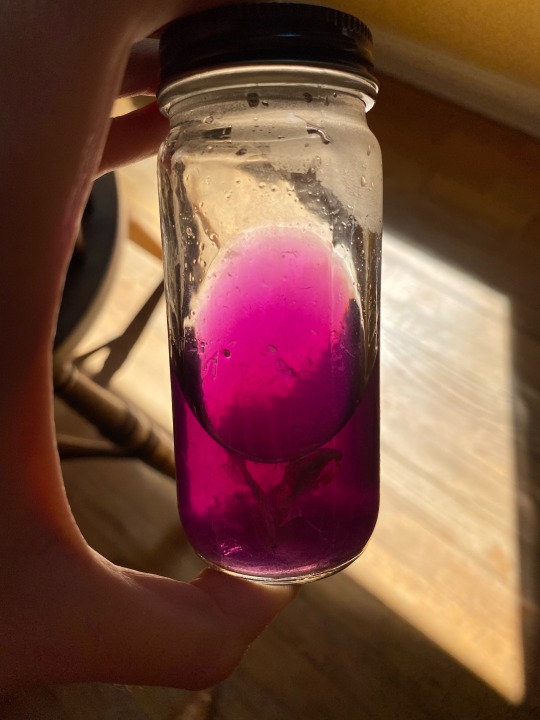
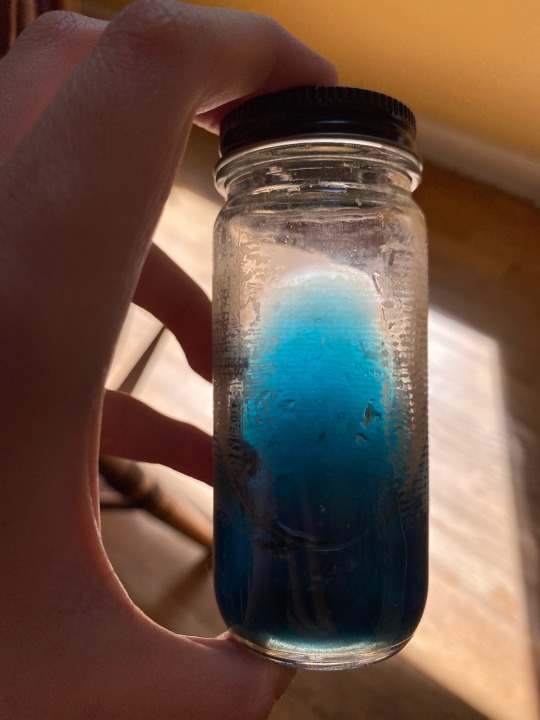
(on the left, i altered it with vinegar and it became a bright magenta color; on the right, i altered it with baking soda and it became a sea green/blue cyan that refused to show up accurately on camera). That's one thing I've noticed, and others have too, is that when working with pigments (especially natural ones) the color accuracy of the camera often just completely fails. there's only so many colors a digital camera can capture!
Here's a slightly more accurate color due to different lighting, note how it's more a malachite green than a pure blue. off the bat this was interesting becuase I wasn't expecting as green of a liquid as i got.

Anyways, the first thing i did with them was use them as-is, no alterations past the addition of the respective vinegar and baking soda. I painted with them just as one would paint with watercolors, and interestingly enough, when i put them onto paper, they began to change from their pink/purple/malachite colors to a teal/indigo/emerald set instead.
This seems to be the result of something in the paper itself, likely calcium carbonate (which i only recently learned is added to "buffer" paper against acidic substances; the cellulose in paper is more stable long term when there's no acid present, and the calcium carbonate neutralizes any acids applied to a degree).
It's still interesting that even though the acids are neutralized, they give a unique color when compared to the basic paint.
I also tried soaking some of the same paper in vinegar water, which got rid of that buffer and let me paint with the pinks intact, but that's for another post.
Also, note that i said "neutral" for the middle, this is just what i wrote down for the tap water sample; in actuality the tap water is actually a bit closer to pH 6 instead of a true neutral 7, which i only found out after i had gotten this far. So whenever i say "neutral," i mean "tap water that's slightly acidic"
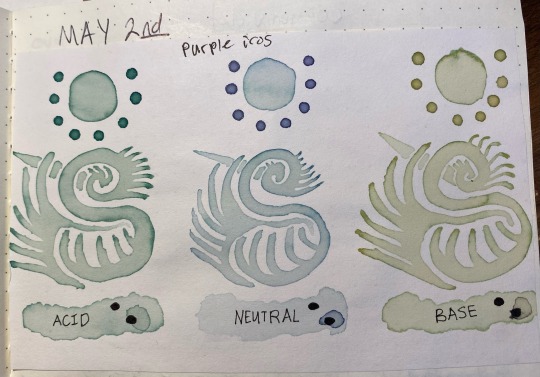
Here's something interesting that happened, though. Overnight i left the jars on my desk, and while the acid and neutral colors were the same when I came back ~24 hours later, the basic had degraded into a murky brown. this was interesting since that meant the instability was pH-dependent.
So, i made another color swatch with the acid/neutral/base, and used that as a comparison to look at how it had changed. Surprisingly, it painted out a yellowy-green instead of a murky gray-brown
here's the murky water that the once-malachite-green turned into:

I also poured off a bit into another container, and shifted it back into a low pH with a bit of vinegar to see if it would still change color. Surprisingly, it turned a slight pink, like pink lemonade, which means there were still anthocyanins in there but they were likely a lot less concentrated than they used to be.
Here's the pink, with a few leftover bubbles from the baking soda/vinegar reaction:
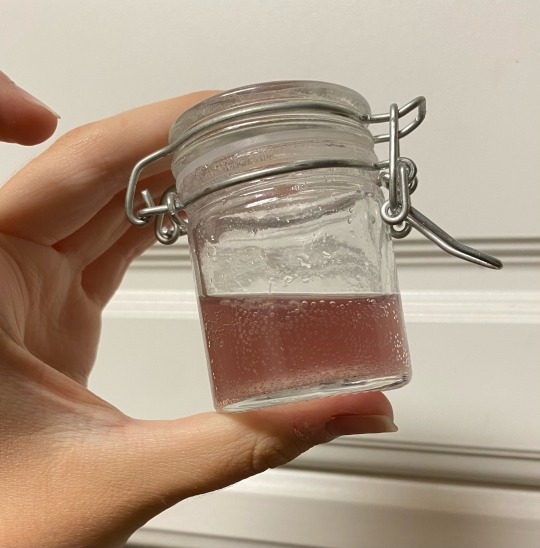
Here's the results of painting with these:
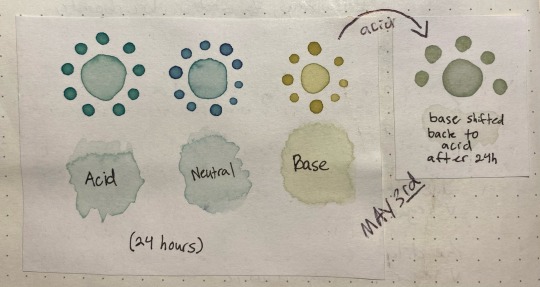
the acid was basically unchanged after sitting in a jar for 24 hours, the neutral had lost a bit of its purple color but was still about the same, and the base was now a lot yellower/tanner with a bit of green still showing through. The shifted sample was a pale stormy gray that ended up taking on a green color as it dried, as though following the trend of pink shifting to a bluer color but on a much more muted scale.
Now obviously, i wanted to figure out what caused this, so i dug around both on wikipedia and other sites but found myself eventually reading into scientific papers on the topic, at which point it became very clear that i would need to learn like, organic chemistry and such to be able to say for sure what was happening.
I did eventually manage to figure out a few things despite the dense terminology; for one thing, anthocyanins are more unstable than other plant pigments such as carotenoids. there are plenty of things that can affect their stability, including the pH of the substance they're stored in. Any higher than pH 7 (basic pHs) and theyll begin to degrade. This explains why the high pH sample lost its blue/green color, and why there was very little left to be shifted back to a pink color.
I also found out that the pH color shift isn't as simple as it seemed. Rather, there are multiple chemical forms of anthocyanins.
At the lowest pHs, basically all of them are in the "flavylium cation" state, which basically means it's positively charged and this is what gives a red color
still at a low pH (2-4), there's anothe chemical form that appears, the "quinoidal" structure that gives a blue color. Note that the red cation is still present, just no longer the only form
the more the pH rises, the more forms start to coexist, with some of those forms being colorless (one of which is a "colorless carbinol"
so, between 4 and 6 there are the cations (red) quinoidal (blue) carbinol (colorless) and something called a chalcone that gives a pale yellow
and then past that, I'm unsure, but of course that's around when the anthocyanins begin to degrade
There are also a lot more than these that i've encountered in various contexts but these seem to be the basic ones.
Do note that i do not fully understand these terms (flavylium, quinoidal, carbinol, chalcone, etc.) and have only recently begun to actually try to learn what they mean and the context surrounding them as i only had a class of basic high school chemistry under my belt prior to this. The main paper i combed over to try to find info on it seems to be behind a paywall but the DOI is:
doi.org/10.1016/j.foodchem.2008.09.001
for anyone curious and able to access it, whether through legit means or what have you.
That being said, to me, the takeaway here seems to be that there's a yellow form that appears around the time that other color forms begin to disappear, and as those degrade it makes sense that the resulting degraded forms also contribute to a murky color. This helps explain why it changed color in the jar and also retained a bit of yellow and green.
This also explains why the blue form seems to also be slightly green, it's got the blue quinoidal chemical form as well as the yellow chalcones.
There are also interesting things of note that I will get into at a later date, such as the texture/reflectivity of the way it dries, the differences in extraction ease between this and purple violets, the addition of a genuinely neutral/pH 7 sample later, a sample from a plant that doesnt seem to have delphinidins, and sample the seems to genuinely sparkle??? Much more of interest to come soon!
#art#traditional art#anthocyanins#watercolors#purple irises#painting#science#natural dyes#pigments#dyes#pH indicators
68 notes
·
View notes
Link
0 notes
Link
#anti-inflammatory#antioxidants#Berries#Cardiovascular#flavonoids#Health#TypesofFlavonoids#Whatisflavonoidsusedfor?
0 notes
Text
0 notes
Link
1 note
·
View note
Text
HVA ER QUERCETIN – ET BRA KOSTTILSKUDD?
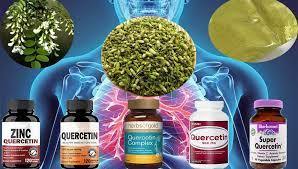
Quercetin is a plant flavanol from the flavonoid gathering of polyphenols. It is tracked down in many natural products, vegetables, leaves, seeds, and grains; tricks,
From Wikipedia, the free reference book
UV apparent range of quercetin, with lambda max at 369 nm
Quercetin is a plant flavanol from the flavonoid gathering of polyphenols. It is tracked down in many natural products, vegetables, leaves, seeds, and grains; tricks, red onions, and kale are normal food sources containing obvious measures of it.[2][3] It tastes unpleasant and is utilized as a fixing in dietary enhancements, refreshments, and food varieties.
Quercetin is a flavonoid broadly conveyed in nature.[2] The name has been utilized beginning around 1857, and is gotten from quercetum (oak woodland), after the oak class Quercus.[4][5] It is a normally happening polar auxin transport inhibitor.[6]
Quercetin is one of the most plentiful dietary flavonoids,[2][3] with a typical everyday utilization of 25-50 milligrams.[7]
In red onions, higher convergences of quercetin happen in the peripheral rings and in the part nearest to the root, the last option being the piece of the plant with the most noteworthy concentration.[8] One investigation discovered that naturally developed tomatoes had 79% more quercetin than non-naturally developed fruit.[9] Quercetin is available in different sorts of honey from various plant sources.[10]
In plants, phenylalanine is switched over completely to 4-coumaroyl-CoA in a progression of steps known as the general phenylpropanoid pathway utilizing phenylalanine smelling salts lyase, cinnamate-4-hydroxylase, and 4-coumaroyl-CoA-ligase.[11] One particle of 4-coumaroyl-CoA is added to three particles of malonyl-CoA to frame tetrahydroxychalcone utilizing 7,2′-dihydroxy-4′-methoxyisoflavanol synthase. Tetrahydroxychalcone is then changed over into naringenin utilizing chalcone isomerase.
Naringenin is changed over into eriodictyol utilizing flavanoid 3′-hydroxylase. Eriodictyol is then changed over into dihydroquercetin with flavanone 3-hydroxylase, which is then changed over into quercetin utilizing flavonol synthase.[11]
3-O-Glycosides of quercetin
Quercetin is the aglycone type of various other flavonoid glycosides, for example, rutin (otherwise called quercetin-3-O-rutinoside) and quercitrin, found in citrus natural product, buckwheat and onions.[2] Quercetin structures the glycosides quercitrin and rutin along with rhamnose and rutinose, separately. Similarly guaijaverin is the 3-O-arabinoside, hyperoside is the 3-O-galactoside, isoquercitin is the 3-O-glucoside and spiraeoside is the 4′-O-glucoside. CTN-986 is a quercetin subordinate found in cottonseeds and cottonseed oil. Miquelianin is the quercetin 3-O-β-D-glucuronopyranoside.[12]
Various taxifolin (otherwise called dihydroquercetin) glycosides additionally exists.
Isoquercetin is the 3-O-glucoside of quercetin.
The protein quercitrinase can be found in Aspergillus flavus.[13] This chemical hydrolyzes the glycoside quercitrin to deliver quercetin and L-rhamnose. It is a catalyst in the rutin catabolic pathway.[14]
The bioavailability of quercetin in people after oral admission is exceptionally low, with one review closing it should be under 1%.[15] Intravenous infusion of quercetin shows a quick rot in focus portrayed by a two-compartment model (starting half-existence of 8.8 minutes, terminal half-existence of 2.4 hours).[15] In light of the fact that it goes through fast and broad digestion, the organic impacts assumed from in vitro examinations are probably not going to apply in vivo.[2][16][17][18] Quercetin supplements in the aglycone structure are less bioavailable than the quercetin glycoside frequently found in food varieties, particularly red onions.[2][19] Ingestion with high-fat food sources might increment bioavailability contrasted with ingestion with low-fat foods,[19] and carb rich food varieties might expand retention of quercetin by invigorating gastrointestinal motility and colonic fermentation.[2]
Quercetin is quickly processed (by means of glucuronidation) after the ingestion of quercetin food varieties or supplements.[20] Five metabolites (quercetin glucuronides) have been tracked down in human plasma after quercetin ingestion.[21][20] Taken together, the quercetin glucuronides have a half-life around 11-12 hours.[20]
In rodents, quercetin went through no huge stage I metabolism.[22] conversely, quercetin went through broad stage II (formation) to create metabolites that are more polar than the parent substance and consequently are all the more quickly discharged from the body. In vitro, the meta-hydroxyl gathering of catechol is methylated by catechol-O-methyltransferase. Four of the five hydroxyl gatherings of quercetin are glucuronidated by UDP-glucuronosyltransferase. The special case is the 5-hydroxyl gathering of the flavonoid ring which by and large doesn't go through glucuronidation. The significant metabolites of orally retained quercetin will be quercetin-3-glucuronide, 3'- methylquercetin-3-glucuronide, and quercetin-3'- sulfate.[22] A methyl metabolite of quercetin has been demonstrated in vitro to be more compelling than quercetin at restraining lipopolysaccharide-enacted macrophages.[18]
Contrasted with different flavonoids quercetin is one of the best inducers of the stage II detoxification enzymes.[23]
In-vitro examinations show that quercetin is areas of strength for an of the cytochrome P450 proteins CYP3A4 and CYP2C19 and a moderate inhibitor of CYP2D6.[24][25] Medications that are used by these pathways might make expanded difference. An in-vivo investigation discovered that quercetin supplementation eases back the digestion of caffeine to a genuinely critical degree in a specific hereditary sub-populace, yet in outright terms the impact was nearly negligible.[26]
Quercetin has been accounted for to hinder the oxidation of different particles and subsequently is delegated a cell reinforcement in vitro.[16] It contains a polyphenolic synthetic base that stops oxidation in vitro by going about as a scrounger of free revolutionaries. Quercetin has been displayed to restrain the PI3K/AKT pathway prompting downregulation of the counter apoptotic protein Bcl-w.[27][28] Quercetin enacts or hinders the exercises of various proteins in vitro. For instance, it is a vague protein kinase catalyst inhibitor.[16]
In 2010, the FDA recognized high-immaculateness quercetin as GRAS for use as a fixing in different determined food classes at levels up to 500 milligrams for each serving.[29]
Quercetin has been concentrated on in fundamental exploration and little clinical trials.[2][30][31][32] While supplements have been advanced for the therapy of malignant growth and different other diseases,[2][33] there is no great proof that quercetin (by means of enhancements or in food) is helpful to treat cancer [34] or some other disease.[2][35]
The US Food and Medication Organization has given cautioning letters to a few makers promoting on their item marks and sites that quercetin product(s) can be utilized to treat diseases.[36][37] The FDA respects such quercetin publicizing and items as unapproved - with unapproved wellbeing claims concerning the counter infection items - as characterized by "segments 201(g)(1)(B) or potentially 201 (g)(1)(C) of the Demonstration [21 U.S.C. § 321(g)(1)(B) and additionally 21 U.S.C. § 321(g)(1)(C)] in light of the fact that they are planned for use in the conclusion, fix, moderation, treatment, or anticipation of disease",[36][37] conditions not met by the producers.
There has been little examination into the wellbeing of quercetin supplementation in people, and the outcomes are lacking to give certainty that the training is protected. Specifically, there is an absence of security data on the impact of quercetin supplementation for pregnant ladies, breastfeeding ladies, kids, and teenagers. The hormonal impacts of quercetin found in creature concentrates on raise the doubt of an equal impact in people, especially in regard of estrogen-subordinate tumors.[38]
Quercetin supplementation can impede the impacts of meds. The exact idea of this association is known for a few normal meds, yet for some, it is not.[38]
0 notes
Text
When the tissue is damaged, the released myrosinase and glucosinolates mix, resulting in the irreversible production of an unstable aglycone, which then rearranges into a variety of biologically active compounds, mostly nitriles and isothiocyanates (Figure 23.14).
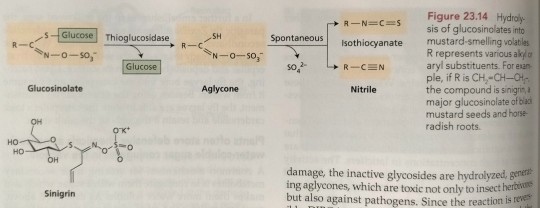
"Plant Physiology and Development" int'l 6e - Taiz, L., Zeiger, E., Møller, I.M., Murphy, A.
#book quotes#plant physiology and development#nonfiction#textbook#hydrolysis#mustard#volatiles#myrosinase#glucosinolate#unstable#aglycone#nitrile#isothiocyanate#sinigrin#black mustard#horseradish
0 notes
Text
Plantain is an amazing plant likely found in your garden. We are not talking about that greenish type of banana but a green plant found in your back yard. People often remove plantain as they find is unattractive, but this little plant has great potential.
Plantain is called the “band-aid” plant as it has soothing and anti-inflammatory properties, all thanks to a natural compound found in this plant: iridoids. Besides this, the plantain contains aglycone and aucubigenin, which have documented antimicrobial properties. As you can see, the plantain is packed with beneficial agents for the skin and, in addition, has allantoin, which promotes skin healing. You may have heard about allantoin as it is often a key ingredient in skin healing creams.
1 note
·
View note
Link
0 notes
Photo



*. * · Lounging Room *. * ·
Fermentation, the process that aids in fabricating a product that is common in most of the food/beverages we consume, it wouldn’t be possible without the help of enzymes that act as catalysts to speed up the chemical process of fermentation.
There are are a total of five enzymes found in vinis vinifera, also known as grapes:
Pectinase - is an enzyme that breaks down pectin, a polysaccharide found in plant cell walls. Its presence in finished wine also clears the haze or slight cloudiness caused by it.
Glycosidases - are enzymes that catalyze the hydrolysis of the glycosidic linkage of glycosidases, leading to the formation of a sugar hemiacetal or hemiketal and the corresponding free aglycon. It is also located mainly in the juice of the grape.
Glucanase - are enzymes that break down a glucan, a polysaccharide made of several glucose sub-units. Treating the wine with glucanase enzymes can improve the wine’s aptitude to clarify and filter.
Urease - is an enzyme that catalyzes the hydrolysis of urea, forming ammonia and carbon dioxide.
Proteases - are enzymes that break the peptide bonds of proteins; they are divided into acid, neutral, and alkaline proteases. It also stabilizes the wine by preventing protein haze.
3 notes
·
View notes
Photo
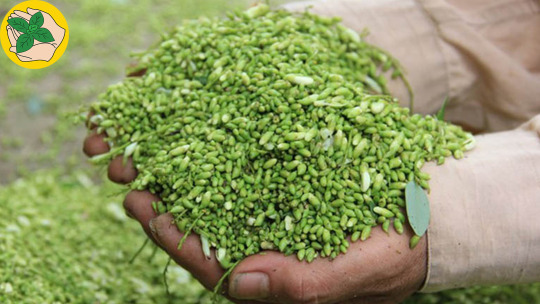
Những người nên dùng trà hoa hòe mỗi ngày
Hoa hòe, hay thường gọi là Hòe hoa trong Đông y (Flos Sophorae japonicum) là một cái tên khá quen thuộc với người Việt Nam. Được xem là một loại thảo dược quý vì có nhiều công dụng tốt cho sức khỏe nên hoa hòe cũng thường được sử dụng hằng ngày. Vậy ai là người nên sử dụng hoa hòe hằng ngày để có được những lợi ích cho sức khỏe, cùng trahoahoe.net tìm hiểu nhé.
Hoa hòe có vị đắng, tính bình, có mùi thơm đặc trưng, có chứa nhiều chất nhóm phytonutrient như flavonoid, troxerutin và oxymatrine, đây là những chất chống oxy hóa và và kháng viêm có hoạt tính cao, do đó có khả năng tăng cường sức đề kháng, giảm tính thấm mao mạch, phục hồi tính đàn hồi của mạch máu, chống viêm, làm giảm sự tiêu hao oxy của cơ tim, cầm máu, hạ huyết áp, bảo vệ gan, chống kết tập tiểu cầu, hạ cholesterol máu, cường tim và giãn động mạch vành, giải co thắt cơ trơn phế quản và ruột,… Ngoài ra,theo Đông y, hoa hòe có vị đắng, tính bình. Hoa vào hai kinh can và đại tràng có tác dụng lương huyết thanh nhiệt, chỉ huyết. Với thành phần và tính chất như trên, hoa hòe phù hợp để dùng hàng ngày đối với những nhóm người sau đây:

1. Những người có vấn đề về giấc ngủ:
Với khả năng lương huyết an thần, nhiều nghiên cứu khoa học đã cho thấy hoa hòe có khả năng giúp chúng ta dễ đi vào giấc ngủ hơn và ngon hơn. Sử dụng hoa hòe để cải thiện giấc ngủ là một phương pháp đơn giản, an toàn đã được nhiều người áp dụng.
2. Người bị bệnh trĩ:
Hoa hòe là một loại thảo dược bổ sung có hiệu quả rất tốt đối với người bị trĩ. Ngoài chấy troxerutin có tính vận mạch có hiệu quả cao đối với bệnh trĩ, hoa hòe còn có oxymatrin, là một chất giúp giảm sưng, giảm sự khó chịu cho người bị trĩ, đồng thời tác dụng làm bền mạch máu cũng hạn chế việc chảy máu ở bệnh nhân. Tuy nhiên việc dùng hoa hòe để trị bệnh mang lại tác dụng hơi chậm, do đó cần kết hợp chế độ dinh dưỡng phù hợp và thay đổi thói quen sống để thấy được hiệu quả.

3. Những người có vấn đề về tim mạch:
Ngoài tác dụng tăng tính bền của mạch máu, hoa hòe còn hỗ trợ hệ tim mạch một cách tổng thể. Loại hoa này có thể hỗ trợ điều hòa nhịp tim và tạo điều kiện hạn chế hình thành cục máu đông. Chất oxymatrine trong hoa hòe có thể giúp cải thiện chức năng tim. Tác dụng phòng ngừa xơ vữa động mạch và làm giảm huyết áp ở người cao huyết áp cũng là tác dụng đáng chú ý của hoa hòe.
4. Người bị cao huyết áp:
Trong bệnh cao huyết áp, việc thiếu Vitamin P có thể làm giảm tính bền của thành mao mạch, khiến mao mạch dễ bị đứt, vỡ, gây ra các biến chứng như tai biến mạch máu não. Trong hoa hòe có một hoạt chất quý là rutin, đây là một loại glycosid thuộc nhóm Flavonoid Aglycon, hay chính là một loại Vitamin P rất tốt cho bệnh nhân cao huyết áp, giúp tăng khả năng chịu đựng của mạch máu. Do đó việc sử dụng hoa hòe trong điều trị cao huyết áp sẽ giúp giảm khả năng xảy ra các tai biến về mạch máu.
5. Những người hay bị chảy máu:
Nhờ khả năng làm tăng độ bền mao mạch cũng như giảm tính thấm mao mạch của rutin, trong y học cổ truyền, hoa hòe được dùng trong các bài thuốc chống chảy máu và cầm máu như cho các bệnh chảy máu cam, đi cầu ra máu, chảy máu tiêu hóa, trĩ, rong kinh, băng huyết…

6. Những người muốn giảm cân, giảm lượng mỡ trong máu:
Vì có khả năng làm giảm tính bám của chất béo trong mô gan, giảm lượng chất béo trong máu, hoa hòe có thể giảm lượng chất béo được hấp thu, do đó có khả năng làm giảm béo phì. Tuy nhiên như bạn đã biết, chế độ ăn uống và sinh hoạt tập luyện hợp lý cần phải được phối hợp thực hiện để hiệu quả được rõ ràng
7. Người dễ bị nóng trong người:
Hoa hòe có tính thanh nhiệt, lương huyết nên phù hợp với những người hay bị nóng trong người thể hiện ở những triệu chứng như lở miệng, táo bón, hay cảm thấy bứt rứt, … Vào mùa hè, trà hoa hòe là loại thức uống giải nhiệt phù hợp cho cả gia đình.
8. Người bị viêm khớp:

Như đã nói trên, nhờ chứa các chất có hoạt tính kháng viêm cao, hoa hòe có thể được sử dụng trong điều trị viêm khớp. Nhiều nghiên cứu đã cho thấy hoa hòe làm giảm sưng và viêm trên động vật như chuột, và cả trên các bệnh nhân viêm khớp mạn tính. Tuy nhiên vì cơn đau do viêm khớp thường khá trầm trọng nên cần phối hợp hoa hòe với các vị thuốc khác, đồng thời tập các bài tập thể dục phù hợp hoặc phối hợp vật lý trị liệu
9. Người lớn tuổi:
Ở người lớn tuổi, hệ thống tim mạch đã phần nào lão hóa qua thời gian, dễ mắc các vấn đề về xơ vữa mạch máu. Hoa hòe với khả năng làm tăng tính đàn hồi, độ bền của mạch máu sẽ giúp phòng ngừa các bệnh và các tai biến liên quan đến mạch máu. Ngoài ra, người già thường gặp các vấn đề về giấc ngủ, sử dụng hoa hòe sẽ giúp cải thiện giấc ngủ. Nhìn chung, hoa hòe rất phù hợp để dùng hàng ngày đối với người cao tuổi
Trên đây là những đối tượng nên sử dụng hoa hòe hàng ngày. Tuy nhiên cần phải lưu ý rằng vì sử dụng hàng ngày nên liều lượng sử dụng phải vừa phải, tránh lạm dụng dễ dẫn đến phản tác dụng. Đối với hoa hòe, để sử dụng hàng ngày nên dùng dưới dạng trà loãng.
Với tất cả những công dụng kể trên, hoa hòe thực sự là một loại dược liệu quý. Hy vọng những thông tin từ trahoahoe.net sẽ giúp các bạn hiểu hơn về hoa hòe và quan tâm sử dụng hoa hòe một cách phù hợp để mang lại những lợi ích tốt nhất cho sức khỏe bản thân và gia đình.
1 note
·
View note
Text
OBAT BATUK BERDARAH ALAMI
OBAT BATUK BERDARAH HITAM KENTAL - Batuk darah cukup umum terjadi. Biasanya batuk darah mempengaruhi lebih banyak wanita dibanding pria. Kondisi ini dapat terjadi pada pasien dengan usia berapapun. Batuk darah dapat ditangani dengan mengurangi fator-faktor risiko. Batuk darah atau hemoptisis adalah keadaan ketika seseorang mengalami batuk yang disertai darah. Batuk darah sendiri merupakan suatu bentuk gejala yang bisa timbul akibat sejumlah kondisi. Jika batuk darah dialami oleh kalangan usia muda yang memiliki riwayat kesehatan baik, biasanya itu bukan merupakan pertanda dari suatu penyakit serius. Akan tetapi, jika yang mengalaminya adalah orang-orang berusia lanjut atau diketahui memiliki kebiasaan merokok, maka ada kemungkinan bahwa batuk darah merupakan gejala dari suatu penyakit serius.
Ciri-ciri darah dalam kasus batuk darah bisa bermacam-macam, ada yang berwarna merah muda atau merah terang, dan ada juga yang memiliki tekstur berbusa atau bahkan bercampur dengan lendir.

Taukah Anda Ada Berbagai Jenis Penyakit Yang Menyerang Paru-Paru.
Paru-paru adalah salah satu organ dalam sistem pernapasan manusia. Fungsi paru-paru sangat penting dalam tubuh karena dapat menyuplai oksigen dan berguna untuk proses metabolisme.
Fungsi-paru-paru yang utama adalah sebagai alat pernafasan. Saat bernapas, manusia menghirup udara untuk mendapatkan oksigen dan paru-paru menarik udara dari ruang tenggorokan. Kemudian, saat dihembuskan, rangka tulang rusuk tertarik ke arah dalam dan diafragma di bawah tulang rusuk bergerak ke atas dan sedikit demi sedikit udara terdorong ke luar melalui batang tenggorokan.
Pentingnya fungsi paru paru bagi manusia diharuskan kita untuk tetap menjaga kesehatan paru-paru, berikut adalah beberapa jenis penyakit Batuk yang disebabkan oleh penyakit paru paru.
1. Batuk Karena TBC
Tuberkulosis (TB) yang juga dikenal dengan singkatan TBC, adalah penyakit menular paru-paru yang disebabkan oleh basil Mycobacterium tuberculosis. Penyakit ini ditularkan dari penderita TB aktif yang batuk dan mengeluarkan titik-titik kecil air liur dan terinhalasi oleh orang sehat yang tidak memiliki kekebalan tubuh terhadap penyakit ini. Gejala klasik infeksi TB aktif yaitu batuk kronis dengan bercak darah sputum atau dahak, demam, berkeringat di malam hari, dan berat badan turun.
2. Batuk Karena Asma
Asma adalah jenis penyakit jangka panjang atau kronis pada saluran pernapasan yang ditandai dengan peradangan dan penyempitan saluran napas yang menimbulkan sesak atau sulit bernapas. Selain sulit bernapas, penderita asma juga bisa mengalami gejala lain seperti nyeri dada, batuk-batuk, dan mengi. Asma bisa diderita oleh semua golongan usia, baik muda atau tua.
3. Batuk Karena Bronkitis
Bronkitis adalah infeksi pada saluran pernapasan utama dari paru-paru atau bronkus yang menyebabkan terjadinya peradangan atau inflamasi pada saluran tersebut. Kondisi ini termasuk sebagai salah satu penyakit pernapasan. Beberapa gejala yang diakibatkan oleh bronkitis: Batuk-batuk disertai lendir berwarna kuning keabu-abuan atau hijau, Sakit pada tenggorokan, Sesak napas, Hidung beringus atau tersumbat, Sakit atau rasa tidak nyaman pada dada.
4. Batuk Karena Paru Paru Basah
Paru-paru basah atau pneumonia adalah penyakit akibat infeksi yang memicu inflamasi pada kantong-kantong udara atau pada alveolus di salah satu bagian paru-paru, atau bahkan keduanya. Paru-paru basah dapat disebabkan oleh serangan (infeksi) virus, jamur, atau bakteri terhadap sistem pernapasan. Gejalaya berupa Batuk (dengan beberapa paru-paru basah Anda mungkin batuk lendir kehijauan atau kuning, atau bahkan lendir berdarah), Demam, yang mungkin ringan atau tinggi, Menggigil kedinginan.
Itulah beberapa penyakit batuk yang disebabkan oleh masalh paru paru. Beberapa penyakit batuk tersebut merupakan masalah serius bagi kesehatan tubuh anda karena penyakit paru paru tersebut tergolong masalah penyakit yang berbahaya.
Obat penyakit batuk yang disebabkan oleh beberapa penyakit di atas dapat diobati dengan obat antibiotik.
Berikut adalah Nama antibiotik yang ada di apotik
1. Penicilin
2. Sefalosporin
3. Aminoglikosida
4. Tetrasiklin
5. Makrolida
6. Fluouroquinoones
7. Obat-obatan pereda gejala
Selain dengan Obat dari apotik anda juga bisa memanfaatkan tanaman herbal disekitar anda untuk membantu pengobatan penyakit batuk yang takunjung sembuh diakibatkan penyakit paru paru.
Berikut adalah beberapa tanaman alami yang bisa anda manfaatkan untuk mengobati batuk , sesaknafas akibat penyakit paru paru. Obat sesak nafas karena tb
1. Bunga Sepatu
Kembang sepatu merupakan salah satu tanaman obat tradisional yang dipercaya berkhasiat dalam mengobati berbagai macam penyakit. Beberapa penyakit yang bisa diobati dengan kembang sepatu antara lain penyakit Paru paru , sariawan, gondok, bronkhitis, sakit kepala dan gonorhoe.
2. Umbi Bambu Tali
Bambu tali memiliki rasa manis,pait dan bersifat mendinginkan. Beberapa bahan alami yang terkandung dalam bambu tali, diantaranya saponin, misalnya aglycone dan proto-sarsapogenin. Selain itu, bambu tali mengandung asparagines glukosa, fruktosa, 5-methoxymethylfufural, dan ß-sitosterol. Bahan alami akan masuk ke meridian paru-paru dan ginjal sehingga dapat membersihkan paru-paru, menyuburkan yin, serta merangsang produksi cairan tubuh. Umbi tali merupakan tanaman obat yang banyak khasiatnya mengonsumsi umbi tali dipercaya dapat mengobati penyakit Batuk darah,TBC,dan sakit kerongkongan, Kanker payudara dan kencing manis.
3. Daun Tembelekan
Daun tembelekan adalah salahsatu tanaman herbal yang memiliki banyak manfaat untuk kesehatan. Banyak ahli herbal yang mempercayai daun tembelekan dapat mengatasi penyakit TBC. Selain daun tembelekan, akar tembelekan ini juga memiliki banyak manfaat untuk kesehatan tubuh, seperti menghilangkan rasa sakit, menurunkan panas dan penawar racun. Untuk mendapatkan manfaat dari bunga tembelakan untuk mengatasi penyakit TBC, bunga tembelekan ini harus di olah menjadi ramuan tradisional.
Nah itulah sedikit pengobatan penyakit batuk dengan tradisional, namun bila Anda ingin memanfaatkan tanaman herbal harus diolah terlebih dahulu dan menggunakan takaran yang tepat jadi serahkan kepada ahli herbal untuk mengolah tanaman herbal yang dipercaya dapat menyembuhkan penyakit batuk akibat masalah paru paru. Berikut saya akan merekomendasikan Obat Paru Paru yang sudah dipercaya oleh banyak masyarakat indonesia dan telah mendapatkan ijin edar.
Detopar & Pipeca

Detopar dan Pipeca Merupakan produk unggulan dari perusahaan De Nature, banyak yang telah sembuh dengan perantara obat dari kami. Obat alternatif yang aman digunakan dan berkwalitas. Hal ini terbukti dengan legalitas yang diberikan pemerintah melalui Badan pengawasan Obat dan Makanan Republik Indonesia (BPOM RI) Produk kami terdaftar BPOM RI No TR163394651 dan DINKES RI No. 442/0060/V.2.

Cara Pemesanan:
- Silahkan kirimkan alamt lengkap terlebihdahulu dengan format
Nama:
Alamat lengkap:
Kodepos:
No Hp
- Silahkan Lakukan Pembayaran terlebih dulu via transfer Bank, setelah transfer SMS-kan konfirmasinya untuk proses pengiriman.
- Agar pesanan Anda bisa segera diproses, segera konfirmasikan pembayaran Anda via TLP & SMS :0813 9276 8419 atau 0813 9276 8419
- Setelah itu barang kami kirim melalui TIKI / JNE / POS.
Sekedar informasi untuk kenyamanan Konsumen, bahwa Produk dari perusahaan kami ini sudah memiliki:
>>Ijin Resmi Perusahaan dari Kementerian Kesehatan
>>De Nature sudah mendapatkan retifikat ISO 2015
>>Ijin BPOM, yang artinya sudah lulus uji stabilitas Produk
>>Sertifikat Halal MUI, sehingga kehalalannya bisa dipertanggung jawabkan
Apoteker Yang berpengalaman
>>Sudah melewati Proses Sortir Bahan Baku, Guna Menjaga Mutu Produk
>>Proses Produksi Sesuai Alur CPOTB (Cara Pembuatan Obat Tradisional Yang Baik Dan Benar)
0813 9276 8419
LAKUKAN PENGOBATAN DENGAN BAIK, BERPIKIRLAH POSITIF
JANGAN STRESS, INSYA ALLOH KESEMBUHAN AKAN ANDA DAPATKAN
1 note
·
View note
Text
Hesperidin
Hesperidin
CAS-No.: [520-26-3]
Specification: 85%-95% HPLC
Extraction solvent: Water
Origin: Dry citrus Aurantium
Description:
Hesperidin is a flavanone glycoside (flavonoid) (C28H34O15) found abundantly in citrus fruits. Its aglycone form is called hesperetin. Hesperidin is believed to play a role in plant defense. It acts as an antioxidant, according to in vitro studies. In human nutrition, it contributes to the integrity of the blood vessels. Hesperidin reduced cholesterol and blood pressure in rats. In a mouse study, large doses of glucoside hesperidin decreased bone density loss. Another animal study showed protective effects against sepsis. Hesperidin has anti-inflammatory effects. Hesperidin is also a sedative, possibly acting through opioid or adenosine receptors. It can maintain normal blood vessels’ osmotic pressure, decrease blood vessels’ brittleness and shorten the bleeding time. In clinical application, it is frequently applied as an adjuvant and anesthetic to cure high blood pressure. It can enhance the effects of Vitamin C, and have
Function:
Hesperidin can decrease the permeability and fragility of capillaries and treat hypertension and hemorrhagic disease of blood capillaries with other medicine.

0 notes
Text
Monarch Butterfly Stages
New Post has been published on https://www.petculiars.com/monarch-butterfly-stages/
Monarch Butterfly Stages
The monarch butterfly is a flying insect from the Nymphalidae family. It is characterized by the colorful patterns of its wings, distinguishing orange and black tones.
Geographically, they are found from southern Canada, through the United States and Central America, to South America. It is a species with a very long life span, it can live up to nine months, unlike most butterflies, which have a 24-day life cycle.
They are known all over the world for the majestic migratory show they offer. Danaus plexippus species participate in a massive and extensive migration process. This happens when temperatures drop in their natural habitat, so they try to hibernate in warmer places.
There are two simultaneous migration processes, in the East and West. In addition to monarch butterflies migrating to other latitudes, there are populations of this species that do not migrate. They are located in southern Florida, all over Mexico, Central America, and North and South America.
Aposematism
Both larval and adult butterfly forms protect themselves from predators using the bright colors of their wings. In this way, they warn their attackers about the problems they would face if they attacked.
These insects have quite an unpleasant taste and are poisonous. This is attributed to the presence of cardenolide aglycone in their bodies. This substance enters the body when the caterpillar eats the milk plant because it contains cardiac glycosides, a very toxic compound.
After the caterpillar evolves into a butterfly, these toxins spread to different parts of the body. It is concentrated in its wings in large proportions because this part of the body is preferred by birds.
When they are attacked, the unpleasant taste is likely to drive the predator away and prevents it from ingesting the rest of the body.
The monarch’s life cycle
Eggs
Eggs are the product of mating between males and females. They are deposited by the female on the underside of a young algae leaf.
Eggs are light green or cream-colored and their shape may be conical or oval. Their size is approximately 1,2 × 0,9 mm. They weigh less than 0,5 mg and have several longitudinal ridges.
You might also like my articles on the life cycle of mealworms and praying mantises, and the anatomy of crickets.
As monarch butterflies age, their eggs become smaller. The development of the egg takes between 3 and 8 days, hatching in the form of larvae or caterpillars.
Larva
The development of the larva is divided into five stages of growth. Once each stage is finished, a mole appears. Each caterpillar will be larger than the one before it because it eats and stores energy in the form of nutrients and fats. It will be used during the pupal stage.
First Instar
The first caterpillar to hatch is translucent and pale green. It has no tentacles or staining strips.
It eats the remaining shell of the eggs, as well as it begins to ingest small parts of the milk leaf. Doing so, it moves in a circular motion, preventing the flow of latex from catching it.
They remain in this stage for about 3 days.
Second Instar
At this stage, the larvae develop a pattern of transverse bands of white, black, and yellow colors. It is no longer translucent. Black tentacles begin to grow on his body, one pair appearing on the chest and another pair on the abdominal area.
As in the previous stage, it remains in this state for about 1 to 3 days.
Third larval stage
In this third stage, the caterpillar has different bands, and the back tentacles are elongated. The ends of the chest are differentiated into two. A smaller pair of legs near the head and two larger pairs behind the anterior ones appear.
At this point, the larva begins to eat along the entire edge of the leaf.
Depending on the temperature, the larva stays in this stage for about 3 days.
Fourth Instar
The caterpillar reaches about 13 to 15 mm in length during this stage. On the milk leaf, the caterpillar develops white spots, close to the its back.
It stays in this stage from 1 to 3 days.
Fifth Instar
The bandage pattern is much more complete at this larval stage, as it includes white spots on the tips. It has two small anterior limbs, very close to the head. In this last phase, the caterpillar culminates in growth, measuring between 5 and 8 mm wide and 25 to 45 mm long.
The larva can chew the petiole of the algae leaves, stopping the latex. Before they become pupa, larvae should consume algae to increase their mass.
Toward the end of this phase, the caterpillar stops eating and looks for a place to pupate. At this time, it is strongly adhered to a horizontal surface, using a silk pad.
Then it hangs from the hind limbs, upside down. Later it becomes a chrysalis.
Chrysalis
The chrysalis is opaque and bluish-green, with a few small dots in golden tones. At typical summer temperatures, it can mature between 8 and 15 days. The cuticle becomes translucent, making the black wings of the animal visible.
At this stage, the caterpillar rotates the silk tampon, then hangs upside down, resembling a “J”. Later he loses his skin, being wrapped in an articulated exoskeleton.
Adult
An adult monarch butterfly appears after about two weeks in the form of a seizure. Once it’s out, it hangs upside down to let its wings dry. After this, the various fluids run into the wings, which expand and stiffen.
In the adult stage, the monarch can extend and retract its wings, allowing it to fly. Their diet includes a wide variety of nectar plants.
Reproduction
Adults are considered mature four to five days after they reach adulthood. Males and females can mate several times. If they hibernate, mating takes place in the spring, before they migrate.
This species has a private courtship. First, there is an aerial phase, in which the male closely follows the female in the heat. At the end of this type of dance the male pushes it and throws it hard to the ground.
There is copulation, in which the male transfers its spermatophore to the female monarch butterfly. Along with its reproductive purpose, spermatophore also provides nutrients, which help the female lay eggs.
The development of the egg and the stage of the larvae depends on the temperature of the environment, lasting about two weeks. At the end of all stages, the caterpillar appears between 9 and 15 days later as an adult butterfly.
Michoacan, the place of destination to find this type of butterfly, is a legally protected sanctuary and one of the most popular tourist attractions in Mexico. Thousands and thousands of people come every year to witness this miracle of nature. Once at their destination, the butterflies cover the entire area, creating a huge black-orange carpet. It is a breathtaking sight, but human greed threatens to destroy this unique landscape in the world. Last November alone, illegal deforestation in the area resulted in the loss of nine hectares of forest.
And here, in the secular forest of Michoacan, there are more than 130 species of birds, 56 species of mammals, and several hundred species of unique plants, all of which together form a unique biosphere.
0 notes